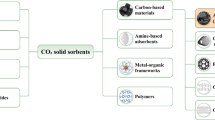Abstract
The coal hydrogenation reaction process is simply considered as three steps. In the first step, the smaller molecules associated with coal structure units are released as some gases and water in the condition of solvent and heating. In this step, some weaker bonds of the coal structure units are ruptured to form free radicals. The radicals are stabilized by hydrogen atoms from donor solvent and/or H2. In the second step, chain reaction occurs quickly. In the process of chain reaction, the covalent bonds of coal structure units are attacked by the radicals to form some asphaltenes. In the third step, asphaltenes are hydrogenated form more liquids and some gases. In coal liquefaction, the second step of coal hydrogenation reaction should be controlled to avoid integration of radicals, and the third step of coal hydrogenation should be accelerated to increase the coal conversion and the oil yield. A new concept of coal liquefaction process named as China direct coal liquefaction (CDCL) process is presented based on the mechanism study of coal liquefaction.
Similar content being viewed by others
References
Shinn J H. From coal to single-stage and two-stage products: a reactive model of coal structure[J]. Fuel, 1984, 63(9): 1 186–1 196.
Shui Hengfu. Non-covalent associative structure of coal[J]. Journal of Coal Science & Engineering (China), 2004, 10(1): 60–64.
Franz J A, Ferris K F, Camaioni D M. Are strong bonds cleaved during coal liquefaction via radical hydrogen transfer? An ab initio theoretical study of thermoneutral radical hydrogen transfer[J]. Energy & Fuels, 1994, 8(5):1 016–1 019.
Coughlin R W, Davoudzadeh F. Lignin depolymerizes coal at 300 °C[J]. Nature, 1983, 303: 789–791.
Lalvani S B, Muchmore C B, Koropchak J. Ligninaugmented coal depolymerization under mild reaction conditions[J]. Energy & Fuels, 1991, 5(2): 347–352.
Vassallo A M, Wilson M A, Attalla M I. Promotion of coal liquefaction by iodomethane[J]. Energy & Fuels, 1988, 2(4): 539–574.
Attalla M I, Wilson M A, Quezada R A. Promotion of coal liquefaction by iodomethane. II: Reaction of coal model compounds with iodomethane at coal liquefaction temperatures[J]. Energy & Fuels, 1989, 3(1): 59–64.
Haenel M W, Narangerel J, Richter U B. The first liquefaction of high-rank bituminous coals by preceding hydrogenation with homogeneous borane or iodine catalysts[J]. Angewandte Chemie International Edition, 2006, 45(7): 1 061–1 066.
Nishioka M, Laird W, Bendale P G. New direction to preconversion processing for coal liquefaction[J]. Energy & Fuels, 1994, 8(3): 643–648.
Priyanto U, Sakanishi K, Okuma O. Optimization of two-stage liquefaction of tanito harum coal with feni catalyst supported on carbon black[J]. Energy & Fuels, 2001, 15(4): 856–862.
一种逆流、环流煤液化反应器串联的煤直接液化工艺[P]. ZL03102672. 9. 2006. A coal direct liquefaction process consists in series with the reverse flow reactor and loop flow reactor[P]. ZL03102672. 9. 2006.
Author information
Authors and Affiliations
Corresponding author
Additional information
Supported by the National Basic Research Program of China (973 Program) (2004CB217605)
Rights and permissions
About this article
Cite this article
Shi, Sd., Li, Wb., Wang, Y. et al. Study on the mechanism of coal liquefaction reaction and a new process concept. J Coal Sci Eng China 14, 119–124 (2008). https://doi.org/10.1007/s12404-008-0024-2
Published:
Issue Date:
DOI: https://doi.org/10.1007/s12404-008-0024-2




